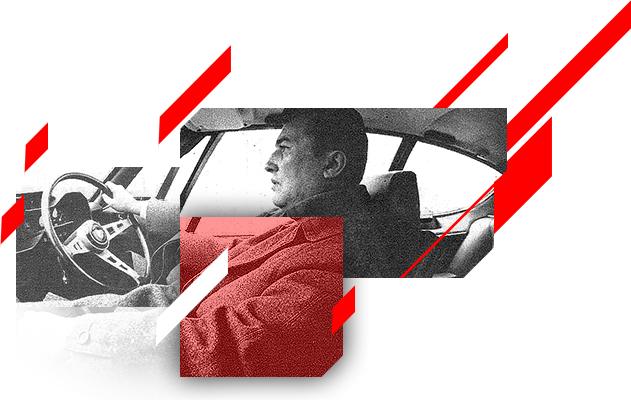
He was one of a kind. A man who challenged current thinking. A man who questioned the status quo. From the first 350GT built, the story of Lamborghini has been the story of one man’s uncompromising approach to his work and his life.Ferruccio Lamborghini was born April 28, 1916 on a farm in the rural town of Renazzo di Cento near Modena.
At a young age, he already had a burning interest in all mechanical objects which continued into his education where he pursued and graduated with an engineering degree from the technical university in Bologna. During the Second World War he was stationed on the Greek island of Rhodes as a ground crew member of the air force.
1946: Start As an Entrepreneur
After his release from British captivity as a prisoner of war in 1946, Ferruccio Lamborghini opened a workshop near his hometown where he assembled vehicles similar to tractors from ex-military vehicles.
Post-war, Italy suffered from a serious lack of agricultural machinery. It is at this time that he threw himself into his new business with ambition, great will-power and a lot of energy and a company arose in 1949 which produced self-developed tractors with two, three and four-cylinder diesel engines. These were modular constructions with numerous interchangeable components. And in 1954, an engine with direct injection was added.
The company Lamborghini Tractori SpA then moved to a new plant manufacturing 400 vehicles per month making the company one of the biggest agricultural machinery manufacturers in Italy in the late sixties.
1960: The Self-Made Man Experiences a Rapid Ascent
Following a journey to the United States, Ferruccio Lamborghini broadened his business in 1960 by expanding into heating and air conditioning. He established a new company, Bruciatori SpA, responsible for manufacturing heating and air conditioning units for private and industrial purposes. This second company also flourished.
With the profits from the two businesses, Lamborghini attempted to realize a dream to manufacture helicopters. The government denied him approval for this project, though.
In 1962, Ferruccio Lamborghini was 46 years old. A self-made man, he had risen to being one of the richest entrepreneurs in Italy. This stocky, energetic man still had both feet firmly on the ground though. His fellow travelers and employees valued his intelligence and his sincere, cheerful and sometimes rural direct nature.
A Passion for Fast Cars
Lamborghini enjoyed his success and the good things in life: good food, fine wines and fast cars. In 1948, he had already built an open sports car on the basis of a tuned Fiat Topolino and took part with this car in the Mille Miglia road race which was extremely popular in Italy at the time. However, the race ended for car number 427 after about 600 miles, as Lamborghini reported himself, “in a bar which I entered with the car through the wall”.
Ferruccio Lamborghini owns a collection of powerful Jaguars, Mercedes, Ferraris and Maseratis, but no car completely satisfies him. In one case, the luxury is insufficient for him and in another case, the ventilation is too weak or the quality inferior or the power transmission noise seems to be too loud for him. Lamborghini is not even happy with the workmanship on his new Ferrari 250 GT. And as a result, requests a meeting with Enzo Ferrari in nearby Maranello, but is refused.
He has the GT taken to pieces by his engineers and recognizes that many of the parts used are standard items. Lamborghini thinks that he could build such a sports car very much better himself and realizes that if he were to do without his expensive motor sport, he would even be able to open up a new, profitable business segment.
1963: The Sports Car Lamborghini Brand is Established
In May 1963, Ferruccio Lamborghini established his own motorcar company, Automobili Ferruccio Lamborghini S.p.A., in Sant’Agata Bolognese – a carefully selected location in the small town between Modena and Bologna. The ultra-modern plant in green meadow land with an area of 50,000 m2 had plenty of space to grow and a location where the tractor and heating factory was not too far away. It was carefully selected because it also was in the middle of the “Terra di Motori”, engine country, home to the factories of Ferrari, Maserati or Ducati, and now Lamborghini as well.
Although a highly qualified source of skilled workers from the sports car industry existed, the wage level was low because the region was otherwise relatively structurally weak. Lamborghini gave the municipality an employment guarantee for his workers and in return he received a long-term interest-free loan. The impatient boss exerted considerable pressure during erection of the factory and after just a year it was complete.
The aggressive bull on the corporate coat of arms already decorated the first Lamborghini sports cars. The head of the company, himself, born under the zodiac sign Taurus, loved this symbol – he saw in it an expression of his forward-urging and occasionally impetuous character.
1972/73: Lamborghini Retires
The success of the sixties was followed by the crisis of the seventies, triggered by a slack economic situation, strikes and intensified regulations in the United States market.
A big tractor transaction that had been agreed with the Bolivian government failed at the last moment in 1972. To support his agricultural machinery company, Ferruccio Lamborghini sold 51 per cent of the shares in the motorcar company to the Swiss national Georges Henri Rossetti.
One year later he sold off the remaining 49 per cent to René Leimer, a colleague of Rossetti. At roughly the same time he lost confidence in the tractor business and sold it to the competing Italian Same group, which continues to manage it up to the present day under the old brand name.
Lamborghini kept only the heating segment as well as another newly formed company by the name of Oleodinamica which produced hydraulic valves — he appointed his son, Tonino, as the manager of this company.
In 1971, the patriarch retired to a 32 hectare estate by the name of La Fiorita. He led the life of a prosperous winemaker in Panicarola/Umbria near to the Trasimenic Lake and set up a small private museum.
Ferruccio Lamborghini, who all his life had always felt best rolling up his sleeves, returned to his roots. He planted grapes to bottle traditional wines including Sangiovese, Gamay, Ciliegiolo, Merlot and Cabernet Sauvignon. His red wine came onto the market with the name “Colli di Trasimeno.” It quickly acquired the colloquial name “Sangue Di Miura”, Miura blood. Lamborghini’s wines have received many awards. They are well established in the international high-end segment due to their exceptional quality.
Ferruccio Lamborghini who was awarded the title “Commendatore” and knighted “Cavaliere Del lavoro” (knight of work), died of a heart attack on February 20, 1993. He was buried in his hometown Renazzo.




